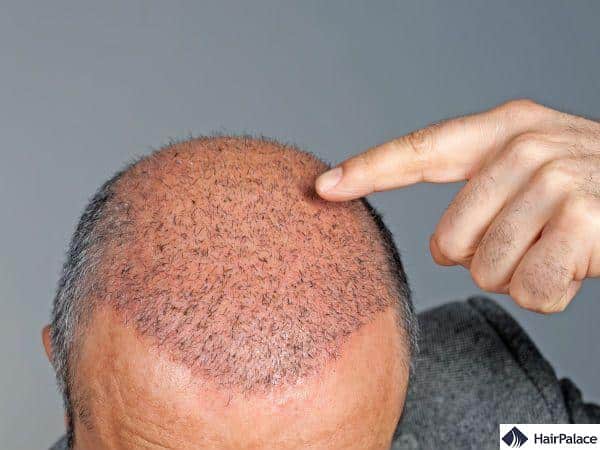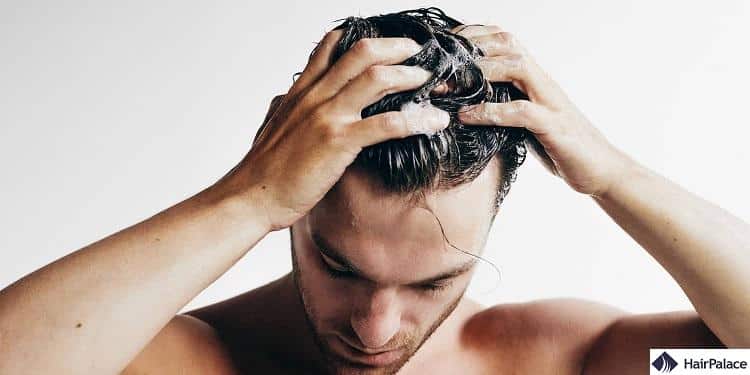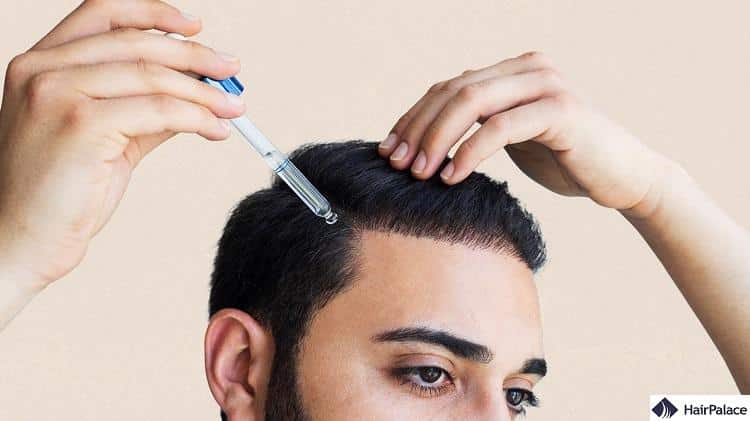After Hair Transplant Surgery: Expert Tips in 2025

No matter which clinic you visit, how skilled your surgeon is, or what technique you decide to undergo, one thing remains the same for every patient, the importance of good aftercare.
After a hair transplant, it’s crucial to keep the scalp dry for the first 48 hours and follow the surgeon’s care instructions to avoid dislodging grafts.
Take prescribed medications to manage pain and prevent infection, and avoid strenuous activities for a few weeks to aid healing.
Expect initial shedding of transplanted hair, with new growth beginning in 3-4 months and full results visible within 12-18 months.
Today we’ll highlight the dos and don’ts after a hair transplant and give you ways to maximize comfort and speed up your recovery.
- Aftercare Quick guide
- Treating the main side effects
- Most important aftercare instructions
- How to speed up recovery
- 3 Optional treatments & supplements
Hair transplant aftercare quick guide
| Medication | antibiotics for a week, painkillers as needed (usually 1-2 days) |
| Sleeping | Week 1: Sleep on your back or your side, use a few pillows to elevate your head, using a U-shaped pillow is recommended. |
| Hair wash | Week 1: no wash, only saline solution Week 2: soak the scalp in lukewarm water and massage it until the scabs fall off Week 3: wash with a gentle shampoo |
| Hats | from week 3 |
| Exercising | lightly from week 3 |
5 common complications after hair restoration surgery
As with any medical procedure, there are some complications you must be aware of.
Below are four potential problems you might encounter:
1. Pain and discomfort
During your hair transplant, your surgeon will numb your scalp to ensure you feel no pain or discomfort.
But in the days following, and as the anaesthesia gradually wears off, you might experience mild pain and scalp soreness.
This is quite common for patients and may only last a few days. Your surgical team may have suggestions on how you can manage your pain effectively.
2. Swelling
This is your body’s response to trauma and is a normal part of every patient’s recovery. Swelling after hair transplant can last 2 to 5 days and usually go away without intervention.
That said, if swelling continues to present itself for longer than one week, you should contact your doctor to ensure everything is OK with your hair restoration.
3. Itchiness
Another common complication of hair transplants is itchiness.
This can last up to two weeks and be quite challenging to ignore. But you must resist the urge to scratch your scalp during recovery.
Any pressure or trauma can damage hair and prolong the healing process.
If the itchiness is unbearable, consult your doctor on possible treatments, like antihistamines, that can help calm symptoms.
4. Shock loss
Shock hair loss after hair transplant means a sudden loss of hair around the donor and transplanted areas of your scalp.
It usually occurs three to four weeks after your procedure and can be distressing to experience, especially as you expect to grow a full head of hair.
But this sudden hair loss is to be expected after any major surgery. The good news is that new hair will start growing afterwards.
But you must be patient. It can take several months for a noticeable improvement to appear, and the final results of your operation will only be seen from twelve months on.
5. Pimples after hair transplant surgery
Pimples after hair transplant surgery can occur and are usually not a serious cause for concern.
These pimples can appear in the recipient area where the new hair grafts have been implanted.
There are a few reasons why pimples might develop after a hair transplant but it’s usually due to inflammation.
It can typically be prevented by following the aftercare instructions and ensuring your scalp remains clean and sterile.
You shouldn’t squeeze or pick at the pimples, simply wash your scalp more carefully and apply gentle scalp massage to the area.
What are the most important elements of my hair transplant aftercare?
Another common complication of hair transplants is itchiness.
This can last up to two weeks and be quite challenging to ignore. But you must resist the urge to scratch your scalp during recovery.

1. Removing scabs after hair transplant surgery during hair wash
The first four weeks after your hair transplant are incredibly important, as this is when implanted hair is at its most vulnerable.
As such, you must change how you wash and maintain your hair accordingly.
While your clinic will give specific instructions, you should avoid washing your hair during the first week of recovery.
Instead, you will sterilize your scalp with a special saline solution to prevent wound infection.
By week 2, you can start to soak and massage your scalp daily with lukewarm water to remove scabs, and by week three, you can use a gentle shampoo (like baby shampoo) to gently but thoroughly clean hair.
Avoid using hair products after a hair transplant, especially ones with harsh chemicals, including silicone, dyes or scents, and perfumes, as these can irritate the scalp.
You should also avoid using heating devices, such as hair dryers, and instead gently pat dry your scalp.
2. Sleep on your back
Sleeping after a hair transplant can be tricky.
You must protect your scalp in the days and weeks following your surgery.
It is highly recommended that you adjust your sleeping position so that your head does not come in contact with anything.
Sleep on your back and elevate your head with soft pillows.
This can reduce complications like swelling and prevent your grafted hair from coming in contact with anything.
3. Minimize sun exposure
You should avoid direct sunlight for at least two weeks following your procedure.
This is because prolonged exposure to the sun can cause dryness, discolouration, and hair thinning.
Many patients think wearing a hat or scarf can help protect their hair. But these accessories can cause damage themselves.
Wearing them too tightly could pressure your tender scalp, pull on new grafts, and ultimately prevent new hair growth.
As such, please wait at least three weeks before wearing them.
4. Limit physical activity
Excess sweating can slow down your recovery and increase your chances of developing an infection.
You should avoid high-intensity exercise for at least three weeks following your procedure.
You can still engage in gentle exercises following your hair transplant procedure.
Short walks, for example, are perfectly fine if you avoid sunlight and stay hydrated.
5. Stay away from alcohol, cigarettes and drugs
Consuming drugs, cigarettes, and alcohol after a hair transplant can harm your recovery.
These toxins can cause stress and irritation and put undue pressure on your immune system.
Unsurprisingly, you should avoid taking alcoholic beverages, smoking cigarettes and cigars, or taking drugs for at least 2 weeks following your procedure.
How to speed up your hair transplant recovery
Certain medications and products can be recommended to you to help support your hair transplant procedure:

- Antibiotics: Often prescribed to help reduce any chance of an infection developing on your scalp.
- Shampoo for hair wash: Baby shampoos are especially useful for patients, as they are gentle on the skin and keep the scalp clean, healthy, and sterile.
- Scarex or Contractubex: Especially for patients who underwent a Follicular Unit Transplantation (FUT), these can be effective in helping to reduce scar visibility.
- Finasteride: This oral pill is known to help bolster thinning hair and reduce the likelihood of future hair loss.
- Rogaine: Minoxidil is a popular over-the-counter medication used to treat and alleviate hair loss.
3 alternative treatments and supplements
1. Biotin supplements
Biotin is a B vitamin that is essential for healthy hair, nails, and skin. It is bought over the counter and is a safe supplement to take.
2. PRP after hair transplant
Platelet-rich plasma treatment, often shortened to PRP, is when concentrations of platelets from a patient’s blood are taken out and injected directly into the scalp to stimulate hair growth.
But you must allow a couple of weeks for your scalp to fully recover from surgery.
3. Dermaroller
A derma roller is a device that massages your scalp, improving blood flow and circulation.
This prompts your body to produce helpful hormones that speed up new hair growth.
You should wait at least two months if you want to use a derma roller after hair transplant.
FAQ After Hair Transplant
Both rest and sleep are incredibly important for anyone recovering from a hair transplant. But because your scalp will no doubt feel tender, finding the right position is crucial.
Sleep on your back in a semi-upright position, using a soft pillow for support. Keep your head elevated, as this can help reduce any swelling you might experience following surgery.
Your doctor will give you clear instructions on cleaning and washing your scalp. This often involves using a specialized saline solution to clean any wounds without causing hair irritation.
Hair transplant recovery time varies between patients, but it generally can take up to three weeks to return to your normal haircare regime after your procedure.
You should avoid wearing hats, scarves, and any accessories on your scalp for at least three weeks following your procedure, even if you’re experiencing hair loss. You need to give transplanted hair enough time to firmly secure itself.
Never pick at or try to remove any scabs that form on your scalp for the first three weeks following your surgery. You can cause damage to implanted hair and prolong your recovery period.
After three weeks, you can give yourself a gentle scalp massage to shift the scabs. Soak the affected area in lukewarm water, and with your fingertips, apply gentle pressure, moving in a circular motion across your scalp.
Following your procedure, transplanted hair can be incredibly vulnerable. You should wait between 10 and 14 days for the hair to fully secure itself in place. Avoid stressing new hair or applying too much pressure to the area during this time.
Most patients can resume normal sleeping positions about 7 to 10 days after a hair transplant, once the transplanted area has sufficiently healed and the risk of dislodging grafts is reduced.
You can usually wash your hair normally about 2 weeks after a hair transplant, following your surgeon’s specific post-operative care instructions.
You should avoid rubbing, scratching, or touching the transplanted area for at least 10–14 days after the procedure. This is crucial to prevent dislodging the grafts and to ensure proper healing. After the 2-week mark, gentle washing and light contact may be permitted, but always follow your surgeon’s specific aftercare instructions.
In the first 5–7 days, it’s best not to cover your head at all to avoid any pressure on the grafts. If necessary, you can wear a loose-fitting hat (like a bucket hat or a soft surgical cap) after the first few days, but avoid tight caps or anything that rubs the graft area. From day 7 onwards, most patients can wear hats more comfortably, but avoid anything snug for at least 2–3 weeks. Always put on and remove headwear very carefully.
Hair grafts are generally considered secure after 10–14 days post-surgery. By this time, the grafts have anchored into the scalp’s blood supply and are less likely to be dislodged by touch, washing, or movement. However, healing varies by individual, so some doctors recommend waiting up to 3 weeks before resuming more active grooming or hair care routines.
Last medically reviewed on April 8th, 2025
- Sand JP. Follicular Unit Transplantation. Facial Plast Surg Clin North Am. 2020 May;28(2):161-167. doi: 10.1016/j.fsc.2020.01.005. PMID: 32312502.https://pubmed.ncbi.nlm.nih.gov/32312502/
- Thomas JR. Techniques for Hair Restoration. Facial Plast Surg Clin North Am. 2020 May;28(2):ix. doi: 10.1016/j.fsc.2020.02.002. PMID: 32312511.https://pubmed.ncbi.nlm.nih.gov/32312511/
- Nadimi S. Complications with Hair Transplantation. Facial Plast Surg Clin North Am. 2020 May;28(2):225-235. doi: 10.1016/j.fsc.2020.01.003. PMID: 32312509.https://pubmed.ncbi.nlm.nih.gov/32312509/
- Jimenez F, Alam M, Vogel JE, Avram M. Hair transplantation: Basic overview. J Am Acad Dermatol. 2021 Oct;85(4):803-814. doi: 10.1016/j.jaad.2021.03.124. Epub 2021 Apr 24. PMID: 33905785.https://pubmed.ncbi.nlm.nih.gov/33905785/
- Collins K, Avram MR. Hair Transplantation and Follicular Unit Extraction. Dermatol Clin. 2021 Jul;39(3):463-478. doi: 10.1016/j.det.2021.04.003. PMID: 34053598.https://pubmed.ncbi.nlm.nih.gov/34053598/


